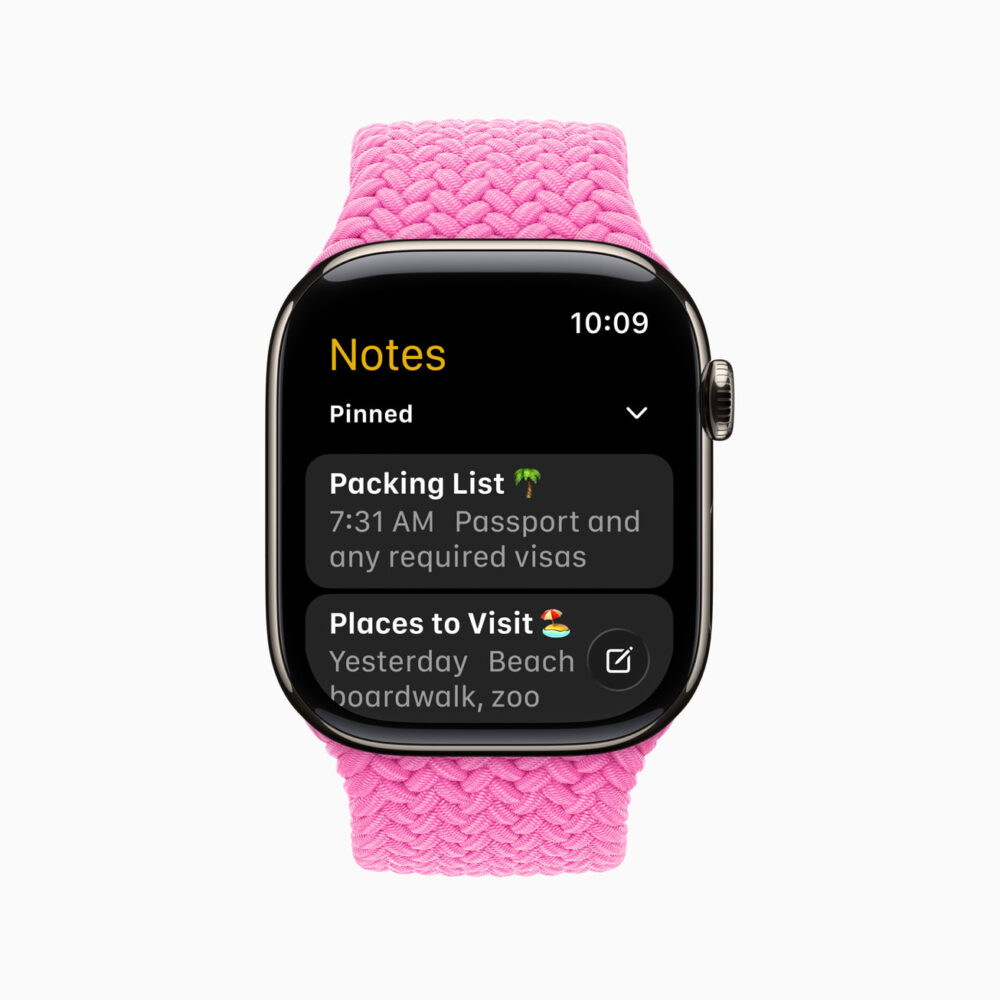Apple has previewed watchOS 26, the latest update to its smartwatch operating system, bringing deeper personalization, Apple Intelligence-powered fitness tools, and interface upgrades designed to enhance how users stay active, healthy, and connected throughout their day. Building on the core principles of privacy, accessibility, and real-time data, the update focuses less on introducing new hardware-specific features and more on refining everyday interactions across health, communication, and intelligent insights.

A Visual Refresh Anchored in Real-Time Design
watchOS 26 introduces a new visual language based on Liquid Glass, a dynamic interface effect that adds real-time depth and reflection to elements across the system. The design extends to Smart Stack widgets, notifications, the Photos watch face, and the Control Center. The aesthetic is designed to be more immersive while preserving the existing UI logic, ensuring users don’t need to relearn navigation.
The Photos face also evolves, now shuffling featured images and incorporating Liquid Glass-rendered numerals that adapt to the content in view, allowing more of the image to remain visible on the screen.

Apple Intelligence Debuts with “Workout Buddy”
One of the most notable additions in watchOS 26 is Workout Buddy, an Apple Intelligence-powered feature that offers real-time, spoken coaching during exercise. Unlike static metrics or preloaded prompts, Workout Buddy draws on a user’s fitness history, current heart rate, pace, and recent activity data to deliver context-aware motivation.
The system uses a privacy-focused, on-device AI model to generate spoken updates using text-to-speech synthesis trained on voice data from Apple Fitness+ trainers. These prompts include both motivational affirmations and detailed performance updates, such as mile splits or new personal records.
Workout Buddy works with Bluetooth headphones and an Apple Intelligence-supported iPhone nearby, and will initially support several activity types including indoor/outdoor running, walking, cycling, HIIT, and strength training.
Improved Workout App Layout and Music Integration
watchOS 26 also introduces the first major layout overhaul to the Workout app since its launch. The new UI adds four corner buttons for quicker access to features like Custom Workouts, Pacer, and Race Route. Music and podcasts can now be directly set to auto-play at workout start, and Apple Music can automatically suggest playlists based on both activity type and the user’s recent listening habits.
This deeper integration with Apple Music offers convenience for those who prefer seamless transitions between physical activity and media without toggling between apps.
Smart Stack Gains Contextual Awareness
The Smart Stack, Apple’s rotating widget system, is now more proactive thanks to enhanced prediction algorithms. Using location, motion sensors, and user routines, watchOS 26 introduces Smart Stack hints, subtle visual prompts rendered in Liquid Glass that suggest relevant actions—such as recommending the Backtrack feature in remote areas without signal or surfacing a Pilates workout upon arrival at a gym.
Third-party developers will also be able to take advantage of new Smart Stack APIs, allowing widgets to surface at the right time based on custom relevance signals.

Messaging and Live Translation on the Wrist
Apple brings Live Translation to Messages on Apple Watch Series 9, Series 10, and Ultra 2 when paired with a supported iPhone. Incoming and outgoing messages can be translated in real-time, supporting multiple languages directly on the wrist. For English-language users, the system will also intelligently recommend message actions, like initiating a Check-In when a friend asks for a location update.

Custom chat backgrounds from iOS now sync to Apple Watch, and users can participate in polls or respond with Smart Replies, which are now more accurate thanks to a new on-device language model.
Hands-Free Interactions and Wrist Flick Gestures
Apple expands its gesture-based interaction model with a new wrist flick gesture available on newer Apple Watch models. Users can now dismiss notifications, decline calls, silence timers, or return to the watch face by turning their wrist over and back. The gesture joins existing features like double tap, offering more accessibility for users with only one hand free.
In noisy environments, the watch can now adjust speaker volume automatically to ensure clarity without disturbing others, applying to notifications, Siri, alarms, and incoming calls.
Additional Features in watchOS 26
- Notes App: Users can now view, edit, and create notes directly on the Watch. Features include pinned notes, checklist support, and dictation or Siri for input.
- Call Management: Call Screening and Hold Assist, previously introduced on iPhone, now come to the Watch when paired with an iPhone. The features help identify callers and notify users when a real agent joins a call.
- Live Listen & Captions: For users who are deaf or hard of hearing, Live Captions now work with Live Listen on Apple Watch, allowing users to view real-time transcriptions of audio picked up by a paired iPhone.
- Photos Face & Face Gallery: The Photos face now cycles through curated “Featured” photos, and the Watch app on iPhone introduces a redesigned face gallery, making it easier to explore and apply watch faces.

Developer Features
watchOS 26 opens new capabilities for developers. The Control Widget API allows creation of custom toggles for use in Control Center, the Action Button, or Smart Stack. Developers can also integrate location-triggered widgets via improved APIs—such as surfacing a ski tracking app when a user arrives at a resort.
Design tools in SwiftUI now support the new Liquid Glass materials, giving third-party apps a more native look. Apple is clearly positioning watchOS as a more flexible development platform with contextual app experiences.
Availability
watchOS 26 is available now in the Apple Developer Program, with a public beta scheduled for next month. The update will be released this fall for Apple Watch Series 6 or later, the second-generation Apple Watch SE, and all Apple Watch Ultra models, when paired with an iPhone 11 or newer running iOS 26.
Apple Intelligence features require an iPhone 15 Pro or later and are limited to devices with Siri and system language set to supported languages. Additional language and feature availability will roll out through the end of 2025.





